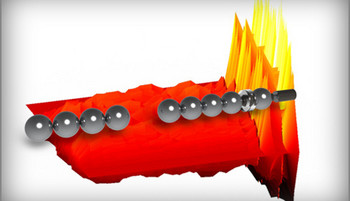Acoustic diode developed
on

Researchers at the California Institute of Technology (Caltech) have now created the first tunable acoustic diode-a device that allows acoustic information to travel only in one direction, at controllable frequencies.
The mechanism they developed is outlined in a paper published on July 24
Borrowing a concept from electronics, the acoustic diode is a component that allows a current — in this case a sound wave — to pass in one direction, while blocking the current in the opposite direction.
The new mechanism brings the idea of true soundproofing closer to reality. Imagine two rooms labeled room A and room B. This new technology would enable someone in room A to hear sound coming from room B; however, it would block the same sound in room A from being heard in room B.
The system is based on a simple assembly of elastic spheres — granular crystals that transmit the sound vibrations — that could be easily used in multiple settings, can be tuned easily, and can potentially be scaled to operate within a wide range of frequencies, meaning its application could reach far beyond soundproofing.
Similar systems have been demonstrated by other scientists, but they all feature smooth transitions between transmitting and nontransmitting states instead of the sharp transitions needed to be more effective at controlling the flow of sound waves. To obtain the sharp transition, the team created a periodic system with a small defect that supports this kind of quick change from an “on” to an “off” transmission state. This means the system is very sensitive to small variations of operational conditions, like pressure and movement, making it useful in the development of ultrasensitive acoustic sensors to detect sound waves. The system can also operate at different frequencies of sound and is capable of downshifting, or reducing the frequency of the traveling signals, as needed. The technology can also shift the undesired frequencies to a range that enables a more efficient conversion to electricity.
The team plans to continue studying the fundamental properties of these systems, focusing on their potential application to energy-harvesting systems. They also believe that these systems may be applicable to a range of technologies including biomedical ultrasound devices, advanced noise control, and even thermal materials aimed at temperature control.
Photo credit: Georgios Theocharis / Caltech


Discussion (0 comments)